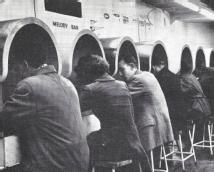Youth Cultures
‘Teenagers’ came into their own as a sub-group in post-war Britain, driven by rising affluence and new mass media forms. Attention from varied social-scientific traditions alighted upon them: from radical concern with the impact of teenage economic consumption on young people’s revolutionary potential, to exploration of the ways in which teenage culture resisted adult norms, and all alongside a new discipline of market research. How did all of these help to ‘create’ teenage culture as much as analyse it?
For seminar preparation, I would recommend at least one primary reading, one secondary reading, and attempting to dip into another primary or secondary as appropriate.
Seminar questions
- What sorts of young people attracted the eye of social researchers during the twentieth century and why?
- How successful was social science in accessing 'youth culture' during this time period?
- How far was the 'teenager' created by market researchers or other social scientists?
- What can we learn from these studies as historians?
Sample reading
Chris Brickell, 'The teenager and the social scientist', New Zealand Sociology, 28:1 (2013), pp. 36-61 [Link]
Laura Carter, 'The haidresser blues: British women and the secondary modern school, 1946-72', Twentieth Century British History, advanced access 2023 [Link]
Daniel O'Neill, '"People love Player's": cigarette advertising and the teenage consumer in post-war Britain', Twentieth Century British History, 28:3 (2017), pp. 414-439 [Link]
Laura Tisdall, '"The school that I'd like": children and teenagers write about education in England and Wales, 1945-1979', in Siân Pooley and Jonathan Taylor (eds), Children's Experiences of Welfare in Modern Britain (London: University of London Press, 2021), pp. 197-219 [Link]
Selina Todd and Hilary Young, 'Baby-boomers to "beanstalkers": making the modern teenager in post-war Britain', Cultural and Social History, 9:3 (2012), pp. 451-467 [Link]
Primary material
Peter Willmott, The Adolescent Boys of East London (London: Routledge & Kegan Paul, 1966)
- Chapter 1, 'The District and the Boys', pp. 8-21
- Chapter 9, 'In Conclusion: growing up in a working-class community', pp. 163-180
- Appendix I, 'Methods of Research', pp. 181-185
- Appendix II, 'Interview Schedule and Interviewers' Instructions', pp. 186-201
- Appendix III, 'Diary Instructions and a Sample Diary', pp. 202-210
Remainder of the volume available in the Library, either at HC1415.W4 or DA685.E1.W5 (floor 5 Ethnicity and Migration Collection)
Mark Abrams, The Teenage Consumer (London: London Press Exchange, 1959)
- A fascinating pamphlet with some great illustrations!
Mark Abrams, Richard Rose and Rita Hinden, Must Labour Lose? (Harmondsworth: Penguin, 1960)
- 'Young Voters', pp. 47-58
Dick Hebdige, Subculture: the meaning of style (London: Routledge, 1979) [e-book]
- Chapter 2
- Chapter 4
- Chapter 5
- Chapter 6
New Society dossier
E.M. Eppel and M. Eppel, 'Teenage values', 14 November 1963 [PDF]
Joan Rockwell, 'A self-portrait of Danish teenagers', 12 February 1970 [PDF]
'Adolescent violence', 13 December 1973 [PDF]
Bernard Davies, 'The life of adolescence', 20 March 1975 [PDF]
Jane Morton, 'Life styles of the young', 22-29 December 1977 [PDF]
Adrian Furnham, 'The ways of the young', 8 January 1988 [PDF]
Further reading
Lise Butler, Michael Young, Social Science and the British Left, 1945-1970 (Oxford: OUP, 2021), chapter 4, 'The Institute of Community Studies, 1953-1958', pp. 101-157
Frank Mort, 'Boys own? Masculinity, style and popular culture', in Rowena Chapman and Jonathan Rutherford (eds), Male Order: unwrapping masculinity (London: Lawrence & Wishart, 1988), pp. 193-224
Melanie Tebbutt, 'Listening to youth? BBC youth broadcasts during the 1930s and the Second World War', History Workshop, 84 (2017), pp. 214-233
Laura Tisdall, '"What a difference it was to be a woman and not a teenager": adolescent girls' conceptions of adulthood in 1960s and 1970s Britain', Gender and History, 34:2 (2022), pp. 495-513
Further primary sources
Stanley Cohen, Folk Devils and Moral Panics: the creation of the Mods and Rockers (London: MacGibbon and Kee, 1972) [available in a later edition as a Library e-book]
J. Douglas, All Our Future: A Longitudinal Study of Secondary Education (London: Peter Davies, 1968)
Andrew Hill, ‘Acid House and Thatcherism: noise, the mob, and the English countryside’, British Journal of Sociology, 53: 1 (2002), pp. 89-105
Richard Hoggart, The Uses of Literacy (Harmondsworth: Penguin, 1958)
Michael Schofield, The Sexual Behaviour of Young People (London: Longmans, 1965)

Young people at a 'Melody Bar'. Image from Mark Abrams, The Teenage Consumer, p. 2.
